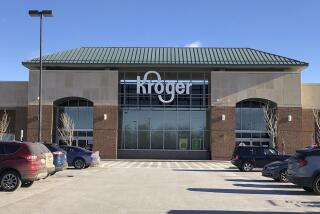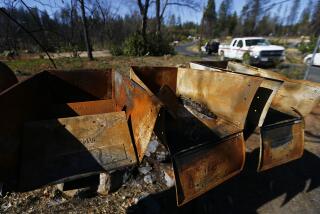Pace of Recovery Raises Concerns About Economy : Commerce: Times remain tough in Southern California and the Northeast, the Federal Reserve reports. Throughout the nation, retail sales are slow and public services are declining.
The nation’s economy is recovering “at a slow, uneven pace,” the Federal Reserve reported Wednesday in its monthly region-by-region assessment that raises the specter of a double-dip recession.
The report shows that retail sales remain weak, manufacturing production is recovering slowly, real estate demand is faltering, and employment in state and local government and many services is declining. Southern California and the Northeast remain economically stressed.
The survey is based on reports from the Fed’s 12 regional districts during the last week of July. Its findings were almost certainly a factor in Tuesday’s surprise move by the Fed to pump money into the system by lowering its target for the federal funds rate, a key short-term interest rate, to 5.5%, the lowest level in more than 10 years.
The Beige Book, as the report is styled, is compiled periodically for the benefit of the Fed’s main policy-making group, the Federal Open Market Committee. The panel’s next meeting Aug. 20 is expected by some market economists to lay the groundwork for future interest rate reductions.
Much of the information in the report corroborates previous economic signals, although it sheds light on regional variations.
In the manufacturing sector, demand is growing slowly nationwide, although more robustly for consumer goods and auto supplies than for capital goods. West Coast manufacturing has been boosted by exports, especially aircraft, although aerospace suppliers are still operating at only 50% of capacity. The upper Midwest and Southeast seemed relatively strong, while New England reported slight declines in factory activity.
Nationwide, retail sales remain sluggish at best. Some growth was evident in the Midwest, Southeast and Southwest, but declines were posted in the Northeast and Southern California, where retailers are still scaling back hiring and laying off workers.
Home sales, which accelerated somewhat in the spring, slowed to a more lethargic pace, and residential construction was reported to be expanding very slowly. Commercial real estate, however, remains plagued by weak markets nationwide, especially in the Northeast and West, where construction financing is hard to find.
In the Southland, the report said, commercial real estate “continues to face high vacancy rates, declining rents and a lack of financing.”
Business loan demand nationwide was reported weak. In Southern California, the report said, long-term financing for commercial real estate cannot be found “except for ‘institutional grade’ projects with long-term leases already in place.”
Deficit-ridden state and local governments have been forced into drastic cost-cutting efforts, including widespread job reductions, the report said. In addition, major restructuring of some service industries, such as airlines and banking, is expected “to cause major employment losses.”
Less dramatic restructuring is causing job losses among professional service suppliers on the West Coast, where a survey of business leaders concluded that 75% “expect no improvement in the unemployment rate over the next year.”
The Economy: A Regional Look (1) Consumer spending remains weak; inventories are lean. Foreign car sales are strong, and home sales improved slightly.
(2) Retail sales are down, and sales of big-ticket items remain sluggish. Office leasing picked up in some areas, but vacancy rates remain high. Unemployment increased in New York.
(3) New orders and shipments continue to increase, but firms are not hiring. Apparel and jewelry sales improved, but department store sales were sluggish.
(4) Gradual improvement continues, with rising employment in recent months. Car sales eased, but orders for 1992 models are at or above normal. Most manufacturers see a recovery.
(5) Manufacturing is improved, but retailing and commercial lending declined. Commercial real estate remained stagnant with no improvement expected.
(6) Retail sales continue to improve. Manufacturing orders and production increased, and inventories of unsold homes fell. Cotton and peanut crops show marked improvement.
(7) Consumer spending posts slight gains, manufacturing activity is stronger, and auto sales continue to improve. Orders for capital goods remain soft.
(8) Car sales are picking up, but spending on general merchandise is flat. Food processors continue to add workers. Weather-related diseases led to a poor winter wheat harvest.
(9) Labor market continues to improve, and retail sales show moderate gains. Housing sales are mixed, and manufacturing appears to be improving.
(10) Cattle industry remains strong, but winter wheat yields were lower. Retail sales were steady, and new home sales increased. Oil and gas drilling improved but still lags last year.
(11) Auto sales are down from a year ago. Retail sales slowed but are showing improvement. Home sales remained steady. Office and industrial vacancy rates increased in several cities.
(12) Economic conditions are weak, especially in Southern California. Consumer spending remains sluggish. Agricultural exports to Mexico and Latin America are growing, while construction and real estate markets remain weak. Layoffs continue.
Source: Federal Reserve
More to Read
Inside the business of entertainment
The Wide Shot brings you news, analysis and insights on everything from streaming wars to production — and what it all means for the future.
You may occasionally receive promotional content from the Los Angeles Times.






